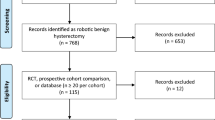Abstract
The goal of this study was to compare outcomes for robotic, laparoscopic, and open hysterectomy procedures for endometrial cancer as well as to investigate whether specific patient demographic, comorbidity, and severity variables were associated with the type of hysterectomy performed. A retrospective review was conducted of hysterectomy procedures for patients discharged from October 1, 2008 and September 30, 2012. Preoperative characteristics included age, BMI, number of past abdominal surgeries, and comorbidities. Intraoperative and postoperative characteristics included uterine weight and diameter, American Society of Anesthesiologists physical status classification, lymph-vascular space involvement, FIGO stage and tumor grade. Outcomes included operative time, estimated blood loss, length of stay, conversion to open, other intraoperative and postoperative complications, readmissions within 30 days and lymph node yield. The robotic and laparoscopic cohorts show no significant differences in patient or tumor characteristics, while the open cases represent patients with increased complexity. In general, laparoscopic cases were shorter than robotic and open cases. Laparoscopic cases had fewer conversions to open than robotic cases. Robotic and open cases had significantly higher lymph node yield than laparoscopic cases. The reduction in surgical time and conversion rates in the laparoscopic cohort may be related to the reduction in node dissection performed.
Similar content being viewed by others
References
American Cancer Society (2016) Cancer facts and figures 2016. Atlanta: American Cancer Society. http://www.cancer.org/acs/groups/content/@research/documents/document/acspc-047079.pdf. Accessed 20 March 2016
Wright JD, Herzog TJ, Tsui J, Ananth CV, Lewin SN, Lu Y, Neugut AI, Hershman DL (2013) Nationwide trends in the performance of inpatient hysterectomy in the United States. Obstet Gynecol 122:233–241. doi:10.1097/AOG.0b013e318299a6cf
DuBeshter B, Angel C, Toy E, Thomas S, Glantz JC (2013) Current role of robotic hysterectomy. J Gynecol Surg 29:174–178
O’Neill M, Moran PS, Teljeur C, O’Sullivan OE, O’Reilly BA, Hewitt M, Flattery M, Mairin Ryan (2013) Robot-assisted hysterectomy compared to open and laparoscopic approaches: systematic review and meta-analysis. Arch Gynecol Obstet 287:907–918
Wechter ME, Mohd J, Magrina JF, Cornella JL, Magtibay PM, Wilson JR, Kho RM (2014) Complications in robotic-assisted gynecologic surgery according to case type: a 6-year retrospective cohort study using Clavien–Dindo classification. J Minim Invasive Gynecol 21:844–850. doi:10.1016/j.jmig.2014.03.016
Gala RB, Margulies R, Steinberg A, Murphy M, Lukban J, Jeppson P, Aschkenazi S, Olivera C, South M, Lowenstein L, Schaffer J, Balk E, Sung V (2014) Systematic review of robotic surgery in gynecology: robotic techniques compared with laparoscopy and laparotomy. J Minim Invasive Gynecol 21:353–361. doi:10.1016/j.jmig.2013.11.010
Twijnstra AR, Blikkendaal MD, van Zwet EW, van Kesteren PJM, de Kroon CD, Jansen FW (2012) Predictors of successful surgical outcome in laparoscopic hysterectomy. Obstet Gynecol 119:700–708. doi:10.1097/AOG.0b013e31824b1966
Van der Schatte Oliver RH, van’t Hullenaar CDP, Ruurda JP, Broeders IAMJ (2009) Ergonomics, user comfort, and performance in standard and robot-assisted laparoscopic surgery. Surg Endosc 23:1365–1371. doi:10.1007/s00464-008-0184-6
Bandera CA, Magrina JF (2009) Robotic surgery in gynecologic oncology. Curr Opin Obstet Gynecol 21:25–30. doi:10.1097/GCO.0b013e32831ffe8e
Sarlos D, Kots LA (2011) Robotic versus laparoscopic hysterectomy: a review of recent comparative studies. Curr Opin Obstet Gynecol 23:283–288. doi:10.1097/GCO.0b013e328348a26e
Boggess JF, Gehrig PA, Cantrel L, Shafer A, Ridgway M, Skinner EN, Fowler WC (2008) A comparative study of 3 surgical methods for hysterectomy with staging for endometrial cancer: robotic assistance, laparoscopy, laparotomy. Am J Obstet Gynecol 199(4):360.e1–9. doi:10.1016/j.ajog.2008.08.012
Bell MC, Torgerson J, Seshadri-Kreaden U, Suttle AW, Hunt S (2008) Comparison of outcomes and cost for endometrial cancer staging via traditional laparotomy, standard laparoscopy, and robotic techniques. Gynecol Oncol 111(3):407–411. doi:10.1016/j.ygyno.2008.08.022
Cardenas-Goicoechea J, Soto E, Chuang L, Gretz H, Randall TC (2013) Integration of robotics into two established programs of minimally invasive surgery for endometrial cancer appears to decrease surgical complications. J Gynecol Oncol 24(1):21–28. doi:10.3802/jgo.2013.24.1.21
Seamon LG, Cohn DE, Henretta MS, Kim KH, Carlson MJ, Phillips GS, Fowler JM (2009) Minimally invasive comprehensive surgical staging for endometrial cancer: robotics or laparoscopy? Gynecol Oncol 113(1):36–41. doi:10.1016/j.ygyno.2008.12.005
Author information
Authors and Affiliations
Corresponding author
Ethics declarations
Conflict of interest
Lynette Johnson, W. D. Bunn, L. Nguyen, J. Rice, M. Raj, and M. J. Cunningham declare that they have no conflict of interest.
Funding
There was no outside funding for this research.
Ethical approval
This study was approved by the Crouse Hospital Institutional Review Board. All procedures performed in studies involving human participants were in accordance with the ethical standards of the institutional and/or national research committee and with the 1964 Helsinki declaration and its later amendments or comparable ethical standards.
Informed consent
This study was conducted as a retrospective study. For this type of study formal consent is not required.
Rights and permissions
About this article
Cite this article
Johnson, L., Bunn, W.D., Nguyen, L. et al. Clinical comparison of robotic, laparoscopic, and open hysterectomy procedures for endometrial cancer patients. J Robotic Surg 11, 291–297 (2017). https://doi.org/10.1007/s11701-016-0651-3
Received:
Accepted:
Published:
Issue Date:
DOI: https://doi.org/10.1007/s11701-016-0651-3




